A large number of drivers in the Pacific Northwest aren’t buying the hype that driverless cars offer a better future.
GovTech.com discussed the findings of a survey by Pemco Insurance of drivers in Oregon and Washington states.
58% of those surveyed believed that the will see autonomous vehicles on roads in the state with thin the next 10 years.
However, more than 40% said they were not interested in buying a robot car, even when price considerations are removed.
Self-driving naysayers represented the bulk of responses, while 23% saying they might consider an autonomous vehicle, and 34% responding that they were very interested in purchasing one.
Perhaps not surprisingly the survey found that younger people were more excited about self-driving cars than their older counterparts. It found that almost half of drivers younger than 35 years old expressed a strong interest in buying an autonomous vehicle in the future.
The Pemco survey polled 600 people in each Oregon and Washington states.
Contrary to this localized antipathy to self-driving cars in the Pacific Northwest, another recent poll found that America as a whole was becoming more amendable to these vehicles.
But most Americans are ready for self-driving cars
A survey by Consumer Technology Association found that 70% of Americans are ready for an autonomous future.
This marks one of the first large surveys to show an overall positive reception for self-driving cars.
Previous results have shown mixed or negative views on full automation, and a worry that self-driving cars will not be able to make the correct decisions at key times.
The CTA survey found that 82% were happy about potential reductions to driving under the influence of drugs or alcohol. The survey showed a positive reaction to potentially lower insurance rates, which is one of the expected advantages of self-driving.
These survey comes as increasing numbers of players around the world are developing self-driving car technology.
Currently in the U.S. robot cars are being tested in Kirkland, Wash. by Google and in Pittsburgh by Uber.
At this stage in the development of the technology, human drivers are still present in the front seat, as a precaution in case they need to take control if necessary.


















